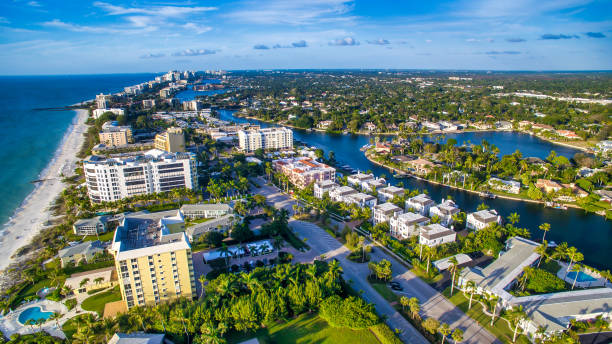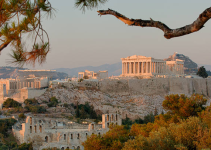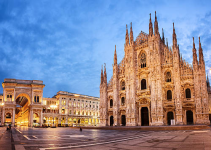Naples hits differently than other Italian cities. It’s louder, messier, and more intense than the polished streets of Florence or Rome. But that raw energy is exactly what makes it unforgettable.
Here’s the thing, though. Naples can chew you up and spit you out if you’re not careful. The same chaos that gives this city its soul can also ruin your trip if you walk in unprepared.
I’m going to walk you through the biggest mistakes visitors make so your Naples experience becomes the highlight of your Italian adventure, not a cautionary tale you tell at dinner parties.

Things to Avoid in Naples
These aren’t just random tips pulled from thin air. They’re the real mistakes that trip up travelers every single day in this incredible, overwhelming, absolutely worth-it city.
1. Driving Your Own Car Through the Historic Center
Your rental car seemed like such a smart idea when you picked it up at the airport. But the moment you enter Naples’ centro storico, that confidence evaporates faster than water on hot pizza dough.
The streets here were built for donkeys, not vehicles. We’re talking alleys so narrow that you’ll fold in your side mirrors and still hold your breath. Scooters zip past you on both sides. Pedestrians step into traffic without looking. And those parking spots you see? Half of them belong to locals who’ve had the same spot for three decades and will absolutely let you know if you take it.
Then there’s the ZTL situation. Limited Traffic Zones blanket most of the historic center, and driving through one means an automatic fine sent to your home address months later. The cameras are everywhere, and they don’t care that you’re a tourist who missed the tiny sign. Each violation costs around €100, and yes, you can rack up multiple fines in a single drive.
Park outside the center and take public transport in. Your blood pressure will thank you. The metro runs efficiently, and a single ticket costs just €1.10. Compare that to the stress-induced gray hairs you’ll get from attempting to parallel park on a 30-degree incline while three Vespas honk behind you.
2. Expecting Northern European Punctuality
You’ve scheduled your 2 PM museum visit, 4 PM coffee break, and 7 PM dinner reservation with military precision. Beautiful plan. Totally wrong city.
Naples operates on what locals affectionately call “flexible time.” That museum? It might open fifteen minutes late because Signora Rossi, who works the ticket counter, stopped to argue about last night’s Napoli match. Your coffee break will definitely run long because the barista wants to chat about your country. And your dinner reservation, well, the restaurant might not even be open at 7 PM because real Neapolitans don’t eat until 9.
This isn’t laziness or disorganization. It’s a completely different approach to living. Neapolitans prioritize human connection over clock-watching. They’ll close a shop mid-afternoon for a family emergency without posting a sign. They’ll spend thirty minutes helping you find an address, even though it makes them late for their own appointment.
Fighting this rhythm will only frustrate you. Build buffer time into your schedule. A lot of it. If someone says “five minutes,” mentally translate that to twenty. If a museum lists opening hours, call ahead to confirm. And if your carefully planned itinerary falls apart because your lunch conversation with a local lasted three hours, congratulations. You’re experiencing Naples the way it’s meant to be experienced.
3. Keeping Your Phone in Your Back Pocket on the Metro
Pickpocketing in Naples isn’t a myth or an exaggeration. It’s an actual, genuine issue that affects tourists daily, especially on crowded public transport and in busy tourist areas.
The technique here is sophisticated. We’re not talking about obvious bumping and grabbing. The best pickpockets work in teams. One person creates a distraction, another positions themselves behind you, and a third does the actual lift. You won’t feel a thing until you reach for your phone thirty minutes later and find an empty pocket.
The metro and buses are prime hunting grounds, particularly the Circumvesuviana line to Pompeii. That route is so notorious among thieves that they literally commute there for work. Tourist-heavy spots like Spaccanapoli, the port area, and the central train station also see constant activity.
Your defense is simple but requires constant awareness. Front pockets only, and keep your hand on your valuables. Use a crossbody bag that sits in front of your body. Never leave your phone on the table at outdoor cafes. And here’s a pro move: carry a decoy wallet with expired cards and small bills in an easy-to-access spot. If you do get pickpocketed, they grab the decoy and leave.
Women should keep purses zipped and in view at all times. Men should know that cargo shorts with velcro pockets might look dorky, but they’re infinitely harder to pickpocket than standard pockets. Fashion takes a backseat to function on the Naples metro.
4. Skipping Travel Insurance Because “It’s Just Europe”
Your buddy went to Paris without travel insurance, and everything was fine. Your sister backpacked through Spain with zero coverage. So why bother with Naples?
Because healthcare works differently here, and because Naples specifically has unique risks. Yes, Italy has excellent medical care. But you’ll pay upfront for treatment as a tourist, then fight with insurance companies back home for reimbursement. That sprained ankle from Spaccanapoli’s uneven cobblestones? Expect to pay €200-300 out of pocket at the emergency room before you see a doctor.
The bigger issue is theft and loss. We just talked about pickpocketing. Add in bag snatching from scooters (a real thing that happens), lost luggage, and stolen cameras, and you’re looking at potential losses in the thousands. Standard credit card coverage typically doesn’t cut it for these scenarios.
Good travel insurance costs about €50-70 for a week-long trip. That same amount won’t even cover a single stolen camera lens. Get the coverage that includes emergency medical, theft, trip interruption, and a 24-hour assistance line. Read the fine print about what’s covered for theft and make sure your electronics are included.
Some credit cards offer built-in travel insurance, but check the details carefully. Many require you to book your entire trip on that card, and coverage limits might be lower than you’d like. Better to know exactly what you’re protected against before you’re standing in a Naples police station filing a theft report.
5. Eating Near Major Tourist Attractions
That restaurant right in front of the Duomo with the picture menu in eight languages and the waiter actively calling people inside? Run. Run fast and far.
Tourist trap restaurants in Naples are particularly offensive because this city has some of the best food in Italy. Paying €20 for mediocre pasta when you could walk three blocks and get incredible food for €8 isn’t just bad value. It’s a culinary tragedy.
These places survive on volume, not quality. They don’t need repeat customers because fresh tourists arrive every day. The ingredients are cheaper, the portions are smaller, and the recipes are watered down for perceived tourist palates. Your carbonara will have cream in it (a cardinal sin). Your pizza will have a thick, bready crust instead of the proper thin, charred Neapolitan base.
The fix is almost too easy. Walk away from the major sights. Seriously, just walk three or four blocks in any direction. Look for restaurants filled with locals eating at 9 PM or later. Check if the menu is in Italian only or maybe Italian and English, but not six languages. Peek in the window and see actual Neapolitan families with their kids. Those are your green lights.
Some specific areas to target: the Sanità neighborhood has incredible spots that tourists rarely find. The waterfront past Via Caracciolo has locals-only seafood restaurants. And honestly, any place with plastic tables and fluorescent lighting that’s packed at 10 PM is probably serving food that will make you weep with joy.
6. Booking Accommodation Far From the Center to Save Money
You found an amazing deal on Airbnb. It’s only €40 a night! Sure, it’s listed as “near Naples” but you figured the metro makes everything accessible. Then you arrive and realize you’re actually in a suburb that requires a 45-minute commute each way, and the last train leaves at 9:30 PM.
This is one of the most common mistakes budget travelers make. The money you save on accommodation disappears immediately in transport costs and wasted time. More importantly, you miss the entire experience of Naples, which comes alive at night. The passeggiata, the late dinners, the street life after dark—these are what make Naples special, and you can’t experience any of it if you’re racing to catch the last train to your distant suburb.
The neighborhoods you actually want are: the historic center (chaotic but central to everything), Vomero (upscale and quieter with great views), Chiaia (stylish and walkable to most attractions), or the Spanish Quarter if you want authentic local life. Yes, accommodation in these areas costs more. Budget €70-100 per night for decent options. But you’ll actually be in Naples, not visiting it like a commuter.
Safety matters too. Some outer areas aren’t particularly dangerous, but they’re not tourist-friendly either. You’ll stand out obviously, the atmosphere can feel unwelcoming, and finding your way around at night becomes genuinely difficult. The historic center has its sketchy corners too, but at least you’re surrounded by other people and well-lit streets most of the time.
Think of it this way: you’ve already spent hundreds or thousands to get to Naples. Saving €30 a night on accommodation while sacrificing the actual experience is penny-wise and pound-foolish.
7. Trusting Every “Helpful” Local Who Approaches You
A friendly guy starts walking alongside you near the train station. He’s asking where you’re from, offering restaurant recommendations, and being incredibly nice. Then he mentions his cousin has a taxi and can give you a great rate to Pompeii. Or he knows a tour guide. Or there’s this amazing shop just around the corner.
This happens constantly in Naples, and while many locals are genuinely kind and helpful, the pushy street operators have refined their approach to an art form. They’re not violent or threatening. They’re affable and charming, which makes it harder to shut them down.
The scam usually involves overpriced services. That taxi to Pompeii will cost three times the normal rate. The tour guide will rush you through in thirty minutes and demand a huge tip. The shop sells low-quality souvenirs at inflated prices and probably gives your new “friend” a commission.
Your guideline: if someone approaches you offering services, be polite but firm in declining. Really helpful locals give you directions or suggestions and then leave you alone. They don’t linger or try to lead you somewhere. If you need a taxi, get one from an official taxi stand or use an app. If you want a tour, book through your hotel or a reputable company.
This doesn’t mean you should be paranoid or rude to everyone who talks to you. Naples has incredibly warm, generous people who love sharing their city. But unsolicited offers of paid services from strangers on the street? That’s your red flag. Trust your gut. If something feels off about an interaction, it probably is.
8. Limiting Yourself to Just Pizza and Pasta
Yes, Naples invented pizza. Yes, the pasta here is incredible. But if your entire meal plan consists of margheritas and spaghetti, you’re missing half the story of Neapolitan cuisine.
The street food scene here rivals anything in Asia. Cuoppo is fried seafood served in a paper cone, and it’s the perfect afternoon snack while walking around. Taralli are crunchy, savory biscuits flavored with almonds or pepper that locals buy by the bag. Pizza fritta (fried pizza) gets overlooked by tourists obsessing over wood-fired pizza, but it’s an entirely different experience—crispy outside, soft inside, and stuffed with ricotta and ciccioli.
Then there’s the seafood. Naples sits on the Mediterranean, and the fish here is spectacular. Try spaghetti alle vongole with clams so fresh they were probably swimming that morning. Get polpo (octopus) that’s been grilled with lemon and olive oil. Order impepata di cozze, which is mussels cooked with just pepper and parsley, letting the natural sea flavor shine through.
Don’t even get me started on the vegetables. Neapolitan cooking treats vegetables like main characters, not afterthoughts. Parmigiana di melanzane (eggplant parmigiana) was born here. Friarielli (a local green similar to broccoli rabe) sautéed with garlic and chili appears on every menu for good reason. Even a simple zucchini dish becomes something special in Neapolitan hands.
And breakfast. Stop going to hotel buffets and hit a local bar for sfogliatella, the shell-shaped pastry filled with sweet ricotta that’s so good it should probably be illegal. Pair it with a proper espresso and you’re starting your day like a real Neapolitan.
9. Visiting Pompeii Without a Plan or Guide
Pompeii is right there, less than an hour from Naples. Obviously, you’re going to visit. But showing up at the gates with no preparation is like going to the Louvre and hoping you accidentally bump into the Mona Lisa.
The site is massive—over 160 acres. Without guidance or research, you’ll wander randomly for hours, miss the best parts, get exhausted, and leave feeling underwhelmed. The ruins don’t come with much explanation on-site. You’ll see amazing frescoes and mosaics, and ancient buildings but have no context for what you’re actually looking at.
A good guide transforms the experience completely. They take you to the must-see spots first before crowds arrive. They explain how Romans actually lived in these houses. They point out details you’d never notice, like ancient graffiti or the grooves worn into stone streets by chariot wheels. They tell stories that bring the dead city back to life.
If you can’t afford or don’t want a guide, at minimum download an audio guide app or buy a detailed guidebook before you go. Study a map and highlight the key areas: the Forum, the amphitheater, the House of the Faun, the Villa of Mysteries, the lupanare (brothel), and the bakery with intact millstones. Plan your route efficiently because backtracking across Pompeii eats time fast.
Practical stuff: bring water and snacks because food options inside are limited and overpriced. Wear proper walking shoes because the ancient stone streets are uneven and slippery. Go early or late to avoid the worst crowds and heat. And budget at least three to four hours, minimum. Pompeii deserves more than a rushed visit squeezed between other activities.
10. Judging Naples by First Impressions
You step off the train or out of the airport, and your first thought is probably something like, “What have I gotten myself into?” The graffiti is everywhere. The streets are chaotic. Buildings look crumbling. Garbage bags sometimes pile up on corners. It’s loud, it’s overwhelming, and it doesn’t match the Instagram version of Italy you’ve been daydreaming about.
This is the moment when many travelers write off Naples. They do a quick day trip to Pompeii, eat one pizza, and flee to the Amalfi Coast or Rome. What a mistake.
Naples reveals itself slowly. You need to give it time to get under your skin. That graffiti you hated? Some of it is actually incredible street art with political messages and cultural commentary. Those crumbling buildings? Many hide stunning courtyards and baroque staircases inside. The chaos starts feeling less threatening and more like energy once you adjust to the rhythm.
The real Naples emerges in moments. It’s in the old woman hanging laundry from her fourth-floor balcony while shouting a conversation with her neighbor across the street. It’s in the soccer game kids play in a tiny piazza while their parents drink coffee at the corner bar. It’s in the family-run restaurant where three generations work together, and the grandmother still makes the pasta by hand.
You have to let Naples be rough around the edges. That’s part of its identity. This city has been continuously inhabited for nearly 3,000 years. It’s been conquered by Greeks, Romans, Normans, Spanish, and French. It’s survived plagues, earthquakes, volcanoes, and wars. It’s not going to sanitize itself for tourists, and thank goodness for that.
Give Naples three days minimum. Walk the neighborhoods without an agenda. Get lost in the Spanish Quarter. Sit in a piazza and just watch people. Eat where locals eat. Talk to shopkeepers. By day three, you’ll start to understand why people fall in love with this maddening, magnificent city. By the time you leave, you’ll probably be planning your return trip.
Wrapping Up
Naples will test your patience and reward your persistence in equal measure. The city doesn’t make things easy, but that’s precisely what makes it so memorable. Every challenge you overcome becomes a story you’ll tell for years.
Skip the mistakes I’ve outlined here, and you’ll spend less time frustrated and more time falling for this incredible city. Because underneath the chaos and the noise, Naples has more soul than a dozen perfectly polished tourist destinations combined. You just have to be willing to meet it on its own terms.


